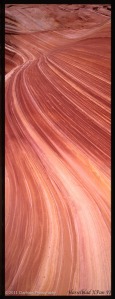On the drive south for a several day trip to the sandstone lands of Utah and northern Arizona, a fellow photographer asked me what gear I had with me. My normal field kit, I declaimed, comprised of two straight DSLRs, two converted infrared DSLRs, a panorama film camera, and lenses ranging from 10mm to 500mm. Politely he asked if all that equipment wasn’t a burden. Au contraire, I said, I find it liberating.
For the next 25 miles or so, we discussed the different, and quite contrary viewpoints. He, with one film SLR and a couple of lenses, felt that it was the essence of liberation as he didn’t need to worry about, much less lug around, a lot of equipment. I understand that perspective and employ it when I am strolling around downtown or perhaps in a small village in Provence. But, for me, photography is also about possibilities and I feel those increase if I have the camera gear to extend and capture my vision. That does not mean that I carry – or hire a Sherpa to carry – all my equipment in the field. Whether traveling overseas or to southern Utah, I can easily leave in the hotel or the vehicle, what I feel I don’t need on a given day. Decisions are made based on locale, likely subject matter, lighting, time of day, and my mood. I don’t always make a perfect decision, but I usually have a range of equipment to closely match the conditions and my inclinations. Limit the gear, limit the decisions, but also limit the possible outcomes. So I believe.
The range of focal lenses probably makes sense to most photographers, but why so many camera bodies? Though never a Boy Scout, being prepared is not only a motto…it makes a lot of sense. I’ve had equipment stolen as well as damaged on trips. Back-ups saved me from being merely a camera-less tourist. There are also times – especially in urban environments replete with the micro and macro details – where having one body mounted with a telephoto and another with a medium or wide-angle zoom lens, allows me to capture a wide range of subject matter, from gothic gargoyles looming high above to panoramas of narrow medieval streets.
Photography is as much about possibilities as it is actualities…perhaps even more so. After all, we strive to match on paper (or screen) what we see in our mind’s eye. We don’t always realize that ideal, but the pursuit keeps us motivated. How you achieve that goal is your liberation.









